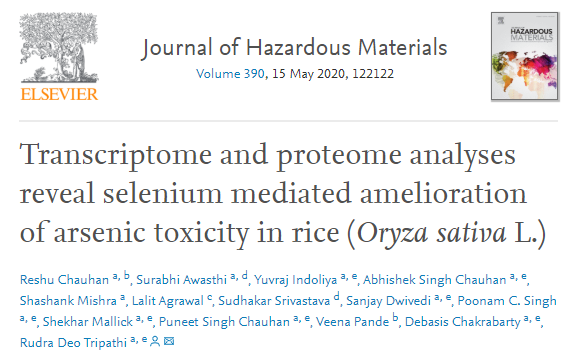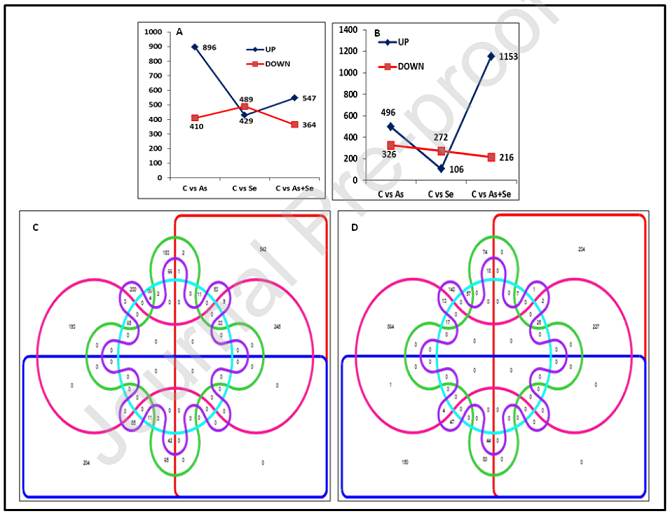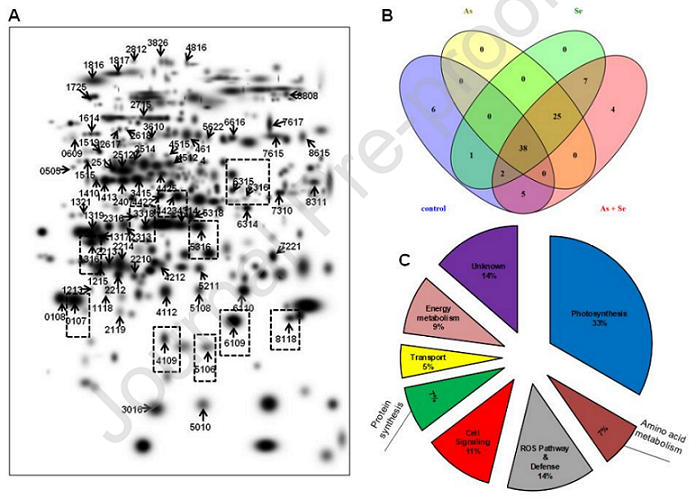Multi-Omics Joint Analysis: Transcriptomics and Proteomics Reveal How Selenium Improves Arsenic Toxicity
Arsenic (As) is a potent carcinogen and toxic to all life forms. Accumulation of arsenic in crops poses a threat to human health. Rice, a staple food for about half of the world's population, is an effective accumulator of arsenic. Consumption of rice and rice-based foods is one of the primary causes of overall arsenic exposure in humans. Selenium (Se) is an essential nutrient for many species, including humans, and is considered beneficial for plants. In earlier studies by the researchers, it was found that selenium supplementation can alleviate arsenic-induced toxicity in rice by reducing arsenic accumulation and mitigating oxidative stress through enhanced antioxidant efficiency and nutrient content. However, detailed molecular analyses are still needed to elucidate the deep mechanisms of As + Se interactions in rice.
The aim of this study is to integrate genomic and proteomic dynamics to understand the changes in the transcriptome and proteome during As + Se interactions, in order to comprehend Se-mediated improvement of As toxicity in rice.

s4
Journal: Journal of Hazardous Materials
Impact Factor: 9.038
Publication Date: May 2020
Article link: https://www.sciencedirect.com/science/article/abs/pii/S0304389420301102
Abstract
Arsenic (As) is a chronic poison and a non-threshold carcinogen, a food chain contaminant in rice, leading to yield reduction and severe health risks. Selenium (Se) is a trace element known as an antagonist of arsenic toxicity. The study explored the molecular mechanisms involved in Se-mediated improvement of arsenic stress through transcriptomic and proteomic analyses, as well as morphological observations. Post selenium supplementation, researchers observed the repair of structural deformities caused by arsenic, including cell wall and membrane breakdown. In the As + Se exposure group, the expression levels of arsenic transporter genes NIP1;1, NIP2;1, ABCG5, NRAMP1, NRAMP5, TIP2;2, as well as sulfate transporter genes SULTR3;1 and SULTR3;6, were higher than in the arsenic-only exposure group, reducing arsenic accumulation and toxicity. Additionally, regulatory factors such as AUX/IAA, WRKY, and MYB TFs exhibited higher expression levels under As + Se exposure. The upregulation of GST, PRX, and GRX indicated an improvement in arsenic-induced oxidative stress. In the As + Se exposure group, proteins involved in photosynthesis, energy metabolism, transport, signaling, and ROS homeostasis were more abundant than in the arsenic-alone exposure group. The study identified selenium-responsive pathways, genes, and proteins involved in combating arsenic toxicity in rice.
Main Findings
This study reports a comprehensive integration of rice transcriptome and proteome profiles to establish the selenium-mediated arsenic stress alleviation mechanism. The study found that transporter proteins (such as NIP1;1, NIP2;1 (Lsi1), NRAMP1, NRAMP5, and the ABC family) play a major role in regulating As and Se interactions, leading not only to reduced As accumulation but also to increased Se levels. Additionally, the roles of sulfate and vacuolar transporters were also evident. Furthermore, the morphological (root and root hair numbers) and anatomical (epidermis, exodermis, sclerenchyma, and cortex) characteristics of root and shoot growth were associated with the enhanced expression of numerous transcription factors, and hormones such as IAA31, IAA14, and WRKY17, WRKY27, and WRKY52 were related to plant growth and As tolerance under As + Se exposure. The auxin-responsive SAUR gene, considered a tool for adaptation in growth and development, also showed significant upregulation under As + Se exposure. Increased expression of antioxidant enzymes (GST30, GST29, PER2, PER12, BAS1, and glutaredoxin, OsGrx_C7) demonstrated Se's antagonistic effect on As toxicity. Changes in gene expression were corroborated by enhanced expression of corresponding proteins involved in photosynthesis, energy metabolism, defense, and transport. This paper provides deeper insights into the metabolic networks of As-Se interactions through analyses of growth, anatomical features, and gene and protein spectra, showing a well-coordinated response mediated by Se across various metabolic pathways and processes, thereby mitigating rice's response to As stress.

Transcript dynamics of plants under different exposures (control, As, Se, and As+Se)

Proteomic analysis of rice leaves under different exposures (control, As, Se, and As+Se)
Baitai Park Biotechnology provides multi-omics integration analysis services, including joint analysis of transcriptomics and proteomics.
We welcome interested teachers to contact us!
Related Services
Integration Analysis of Transcriptomics and Proteomics
Transcriptome Sequencing
Proteomics
Multi-Omics Integration Analysis
How to order?





